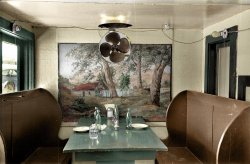
MAY CONTAIN NUTS

Search Shorpy
SHORPY ART

Framed or unframed, desk size to sofa size, printed by us in Arizona and Alabama since 2007. Explore now.
Join and Share
Ad-Free Shorpy
Shorpy is funded by you. Patreon contributors get an ad-free experience.
Learn more.

Recent comments
- A Beautiful Moment
- Such joy
- Bethune-Cookman University today...
- Yellow sky at morning
- Side Winder
- Air Quality?
- Sojourner Truth riot
- None were so blind(ed)
- The less famous sister
- Good ol' days?
- Rise and Fall
- Goo Goo Ga Joob
- Ticket Retention
- Not the only one
- Vagaries of War
- Killed by Amtrak
- Back to the Future
- Wanted --
- If you can't stand the light
- Centralized Traffic Control, I believe
- What's really happening
- Heckuva remote control!
- Sometimes — Things Go Bump!
- I SEE THE LIGHT
- Union Switch and Signal Company
- Get That Light Out Of My Eyes
- Eggs. Eggs. Eggs. The Egg Man is Here!
- Foreboding caption
- Famous Hollywood faces
- Not just S&P
Member Photos
The Shorpy
Print Emporium
Print Emporium
Search Shorpy
Search results -- 30 results per page
- With Both Barrels: 1937
- ... Near Wheelock, North Dakota." Medium format negative by Russell Lee for the Farm Security Administration. View full size.
Disgruntled ... Posted by Dave - 02/23/2018 - 1:30pm -
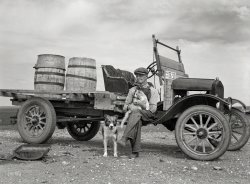
- Rancho Geranium: 1936
- ... that was formerly residence of owner-operator." Photo by Russell Lee for the Farm Security Administration. View full size.
No wonder ... Posted by Dave - 05/24/2018 - 5:10pm -
![Rancho Geranium: 1936 November 1936. "Window of farmhouse living room. Mercer County, Illinois. Hired man lives in house on farm that was formerly residence of owner-operator." Photo by Russell Lee for the Farm Security Administration. View full size.
No wonder Dave and tterrace are tiredThe answer from tterrace to IllinoisBoy reminded me of something I've been meaning to mention. Not sure the average Shorpy.com viewer realizes how many photos the Shorpy crew must have to wade through to find their wonderful offerings.
Over 30 years ago, I was working at an engineering firm outside D.C. and one of the suits there wanted to see every public-domain photo of hurricane damage. So I went to the Library of Congress, first to the old building, and then to the LoC Jefferson (I think) building across the street, to see what they had.
They had about a million filing cabinets with sorted and labeled plates, prints and negs, and I, of course, when shown all that said, "To heck with it."
Same with the Pentagon's photo collection. I used to go to their photo lab at Bolling AFB, and there were three or four Navy guys in civvies digitizing all their imagery using flatbed desk scanners. The director said they had over 5 million images to scan and classify. I said, "With those few guys scanning one by one, how long's that gonna take?!?!?" and the director said, "We figure about 250 years."
Of course, fast and automated scanning came out and that stuff is probably all online already, but it's still a lot of imagery to wade through. So thanks to the Shorpy.com team!!!
Further Information?I'm very curious if there is any further information regarding this photo or the collection?
My great x3 grandfather homesteaded in Mercer County IL in the early 1850's. For several generations my family continued to farm just outside of New Windsor until the early 1980's.
[It's part of this collection at the Library of Congress. -tterrace]
(The Gallery, Agriculture, Russell Lee)](https://www.shorpy.com/files/images/SHORPY-8b29943a.thumbnail.jpg)
- Expert Lubrication: 1939
- ... station in Harlingen, Texas." Medium format negative by Russell Lee for the Farm Security Administration. View full size.
Cans Along ... Posted by Dave - 11/17/2017 - 11:36am -
![Expert Lubrication: 1939 February 1939. "Service station in Harlingen, Texas." Medium format negative by Russell Lee for the Farm Security Administration. View full size.
Cans Along the BorderThis is the service station of Lonnie Wade Molder (1911-1993), the son of Abraham Molder and Pearl Adair. Lonnie graduated from Harlingen High School in 1928, and then Brownsville Junior College in 1930. He married Edna Faye Swisher in 1935, and they had four children. It appears that he owned this station based on Harlingen city directory entries from 1944 to 1948.
Of interest in the photo is the array of oil cans that are the border to the shrubs at both the left and right of the photo as well as the change in gas price, from 16 to 15 cents, as seen on the sign on the canopy above the pumps. All of the planters, including the ones attached to the windows, appear to be reutilized gas tanks. A clearer view of the "Won Up" soda sign is below.
The Chevrolet pickup truck is a 1937 model and cost $515. This was the first year for the all steel cab (no wood). Based on the license plate, I believe this photo is actually from 1938 (the 1939 - 1941 commercial plates had "Texas" at the top). The enlarged license plate is also below.
Molder continued to own and operate the station into at least 1948. By 1950 he was a partner in North Side Welding & Repair down the street at 622 Commerce. By 1956 he had become the assistant manager for the service station at Harlingen Air Force Base (now Valley International Airport). He eventually went back to welding, and he was employed with Gulf Welding Supply in Harlingen for many years.
It appears that he retired in 1975. He and his wife then moved to LaFeria, Texas, in 1979, and by 1992 they were living in Ingram. He died the next year, Edna in 2006. From her obituary we learn that they met while she was still in grade school at South Ward School (now Bowie Elementary). Since he was seven years older, they would not have attended school together for any long period of time.
Molder's obituary mentions his involvement in the Masonic Lodge of both Harlingen and LaFeria. He served as the secretary for the Harlingen lodge for 35 years, he was a 32nd Degree Mason, and he received their Golden Trowel award in 1991.
Try that todayTexaco and Shell pumps at the same station!
Competing Brands?This is the first gas station I've ever seen with pumps for at least two different brands of gas, and the third pump seems to be unmarked. Was this common before WWII?
[For more buffet-style gas, click the links below. - Dave]
https://www.shorpy.com/node/4287
https://www.shorpy.com/node/20712
Flowers by FordI believe that the planter on the ground at center is made from a Model T gas tank.
Who dropped the ball?Unless my vision is failing me, this is one of the first pictures of a service station, convenience store or street scene that does not have an advertising sign for Coca-Cola, although I do see that the 7 Up rep and some other unknown beverage did get advertising signs as did the telephone company that is also a fixture in most old Shorpy photos of this nature.
[No Coke. Pepsi! - Dave]
An original "pumping gas story"During WWII, my uncle in Vinita, Oklahoma, owned a wholesale gasoline business. He had a 750-gallon tanker truck and would deliver to nearby country gas stations and to farms that had their own small storage tanks. My cousin and I, both 10 years old, would ride along to add interest to our lazy summer. In those days, there were two grades of gas, Ethyl and Regular. At one stop, he made the error of filling the Ethyl underground tank with Regular. In a hurry, he left the two of us to hand pump the Regular into the glass bowl and then drain it into the Regular tank. Ten gallons at a time. When he returned, both of us kids were really worn out. An aside: all gas was rationed. Civilians had 3 classes: A, B, and C. I think for 4, 8, and 12 gallons per week. Then there were commercial and farming classes based on need.
(The Gallery, Cars, Trucks, Buses, Gas Stations, Russell Lee)](https://www.shorpy.com/files/images/SHORPY-8b37234a.thumbnail.jpg)
- May Avenue Camp: 1939
- ... chicken coop. Corn patch." Medium format negative by Russell Lee for the Farm Security Administration. View full size.
Ask the man ... Posted by Dave - 05/04/2018 - 5:26pm -
![May Avenue Camp: 1939 July 1939. Oklahoma City. "Shacks, tents, other makeshift shelter in May Avenue camp, which is partially under bridge and adjacent to city dump and hog wallow. Photographs show squalor, filth and vermin in which poverty-stricken inhabitants dwell. Water supplied by shallow wells and water peddler. Piles of rubbish and debris in which children and adults have injured feet. Privies. Families eating food from vegetable dumps, packinghouses and discarded from hospital. Children clothed in gunny sacks. Malnourished babies. Sick people. Cooking, washing, ironing, patching. Improvised chicken coop. Corn patch." Medium format negative by Russell Lee for the Farm Security Administration. View full size.
Ask the man who owns oneThat was Packard's tagline, not Buick's, but imagine being able to walk up to the then-current owner of that car and ask.
Or ask the owner of a 2004 Buick today. You think he or she is the original owner? Let's not forget that modern cars last much longer.
No, the original purchase price of a fourteen-year-old car parked under a bridge in 1939 means nothing. Look at this woman's clothes. They tell the story the 1925 Buick only pretends to conjure.
Wouldn't you really rather havea Buick? Well, this gent does. Clearly this is a man who once had money, given his car is a 1925 Buick Master 6 Touring Sedan and was a quality, up-market car in its day. Now, 14 years later, the crash has come and gone, leaving him with his one friend and grand possession, his lovely old Buick, which lives on to remind him of his prior glory. Now he's buying oil by the gallon, and not very good oil either, so his poor 6-cylinder is likely suffering from worn piston rings and using oil at a rapid pace. I do wonder, what's become of the man and his Buick?
[This is the kind of car Okies bought for next to nothing during the Depression and then drove out to California. - Dave]
(The Gallery, Boats & Bridges, Great Depression, OKC, Russell Lee)](https://www.shorpy.com/files/images/SHORPY-8b22562a.thumbnail.jpg)
- Good for Life: 1942
- ... for Japanese-Americans." Medium format nitrate negative by Russell Lee for the Office of War Information. View full size.
Summer job My ... Posted by Dave - 03/23/2016 - 1:21pm -
![Good for Life: 1942 July 1942. "Nyssa, Oregon. Farm Security Administration mobile camp. Soda pop is delivered at the camp for Japanese-Americans." Medium format nitrate negative by Russell Lee for the Office of War Information. View full size.
Summer jobMy summer job for four years in high school and college was working in the local Coca-Cola bottling plant, loading and unloading trucks like this one. There were no high-loaders or lifts, it was all done manually. To load a row of cases in the top rows, you had to climb up the side of the truck and push with your foot, since the row was too heavy to push by hand (at least for me). To unload empty cases, you could usually push the row by hand, but you still had to climb the side of the truck to grab them, depending on the height of the truck and how tall you were. Then, after unloading, all the empty cases had to be sorted by hand: all the Coke bottles in separate cases, all the Pepsi bottles in others, etc. Sometimes you'd find "strange" things in a returned empty bottle, e.g., a dead mouse or a cigar. One of the job's benefits was free Coke, all you wanted, and you soon learned that not all Coke tasted the same. The best was "post mix", the syrup used in fountains, where the syrup and carbonated water were mixed on the spot. Next best was "pre mix", where the syrup and water were pre-mixed in large metal cans, for businesses, county fairs, etc. The last was regular bottled Coke. This of course was in the days when Coke contained cane sugar, not high-fructose corn sugar. I thought I had the best summer job in town.
My First Impression"How come you're not in the service, mister?"
[Answered here. -tterrace]
Glass bottles = best tasteThe oldsters among us will know that those old time glass bottles, despite their inconvenience, gave one the best burst of flavor one could receive from a bottle of soda without the metallic tones of aluminum or the chemical betrayal of plastic. I fondly recall that at large summertime picnics usually put on by community groups, religious and ethnic clubs when I was a child, we always looked forward to the individual glass bottles of frigidly cold, fruity, delightful flavors and colors seen in those huge galvanized tubs containing vast amounts of crushed ice and nestled within that ice, like jewels, were tantalizing glass bottles of vivid lime green, bright orange, red cherry, purple grape, root beer and other tempting choices to enjoy with one's hot dog or burger. Since my siblings and I were always expected to share a single quart bottle when we were at home, at these special affairs we would each get our very own and would often drink ourselves silly. There really is something sensory and unique about a crystal clear, frigid, refreshing flavor from a glass bottled beverage on an oppressively hot, sweaty summer afternoon. Just another memory from the "long-ago" that will never come again.
Soda pop is deliveredThen empties are picked up and loaded.
Before there was a dosage recommendationIn later years, Dr Pepper eliminated the 'period', and the tag line became 10 - 2 - 4.
Those were the optimal times for the beverage.
(The Gallery, Cars, Trucks, Buses, Relocation Camps, Russell Lee)](https://www.shorpy.com/files/images/SHORPY-8c32512a.thumbnail.jpg)
- Municipal Light: 1940
- ... plant in Silverton, Colorado." Medium format negative by Russell Lee for the Farm Security Administration. View full size.
Lighthouse ... Posted by Dave - 09/01/2018 - 6:07pm -
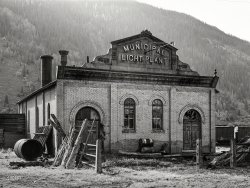
- Buick Badges
- ... here . View full size.
(Cars, Trucks, Buses, Russell Lee) ... Posted by Dave - 01/30/2008 - 12:16pm -

- Road Locomotive: 1920
- ... sure.
Yards Per Gallon Holy cow! I think some of Russell Lee's Resettlement Administration families lived in shacks that had less square ... Posted by Dave - 08/03/2012 - 3:03pm -
![Road Locomotive: 1920 The actress Grace Valentine circa 1920 in an expensive looking Packard roadster. 5x7 glass negative, George Grantham Bain Collection. View full size.
Size MattersThe equivalent of today's $60,000 Hummer in size and price. I can't get over how big this "car" is, if it can even be called that. I love Packards.
[I would guess that this car cost the better part of $10,000. - Dave]
Custom BodyWow! What a car. This is indeed a Packard, with a custom body probably supplied by one of the several coachbuilding firms then in business. In fact, with all the distinctive features it has I wouldn't be surprised if someone wrote in and identified the builder.
Oh yeah ..Looks like it was built like a tank! It ain't a Prius, that's for sure.
Yards Per GallonHoly cow! I think some of Russell Lee's Resettlement Administration families lived in shacks that had less square footage than that car. What would the gas mileage have been on such an automobile?
The CarWhat's the purpose of the flap on the hood in front of the windshield? Also, can you open the door only by a latch on the inside? I guess it takes a certain amount of finesse to stand on the little step, open the door and swing yourself in.
Custom Packard"My other car made me look fat."
Cowl VentThe flap in front of the windscreen is a cowl vent to direct fresh air to your feet. The one on the side just in front of the door is most likely a vent also, and the square panel in front of the rear fender is an access for greasing the rear springs.
That PackardSolid metal wheels at a time when most cars still had wood spokes.
Those wheels are huge!Puts today's 20-inch rims to shame.
Packard Twin Six"A landmark that established the V-12 engine as the ultimate luxury-car powerplant." The Twin Six was powered by a 424 cubic-inch engine, the first automotive V12, and rode on 37-inch wheels. Nice writeup here:
http://www.drivingtoday.com/greatest_cars/packard_twinsix/
Good Luck"... and rode on 37-inch wheels."
Good luck trying to change one of those with a fence post and some rocks.
(The Gallery, Cars, Trucks, Buses, G.G. Bain, Movies)](https://www.shorpy.com/files/images/32802u_0.thumbnail.jpg)
- Scooby-Doo: 1967
- ... fact, it was a link to the Kodachrome-Pie Town series by Russell Lee that got me hooked on Shorpy. Line and sinker were quick to follow.
... Posted by delworthio - 09/22/2011 - 6:16pm -
![Scooby-Doo: 1967 All five kids plus Tippy the wonder dog in Rochester, Indiana. Kodachrome slide. View full size.
Scooby DooI see that the two youngest kids, even the baby still in diapers, are packing heat. It is what "dates" the photo since today it is difficult to find toy guns for boys, even though my kids had dozens, and not one out of four grew up to be outlaws. I bet none of these kids did, either. All the kids in my day had them, none became criminals or murderers. Who remembers WHEN and WHY it became forbidden to sell toy guns?
["Forbidden"? Guns are still big sellers at toy stores. - Dave]
Coloured photosColoured photos are really awful and they spoil this site.
Wonderful shotThe boy with the finger dangerously close to nose-picking territory makes it an excellent, unposed shot where everyone is clearly having a great time.
I like color shotsA lot of us grew up with Kodachrome and those brilliant, very-saturated images are very nostalgic.
Fan of "coloured photos"I totally disagree. I have been enjoying these family Kodachromes; I believe there's a place here for both black & white and color. In fact, it was a link to the Kodachrome-Pie Town series by Russell Lee that got me hooked on Shorpy. Line and sinker were quick to follow.
~mrs.djs
Great MixYou have a great mix of color and B/W photos on this site. Don't change a thing!
A third vote for colorBecause the past WAS in color, even when the photographs aren't.
From my 10 year old"What's the difference between broccoli and a booger? Kids won't eat broccoli!"
I love the mix of the colored and older pictures. This site is one of my daily musts!
Seems like just yesterdayI'm becoming quite fond of these children- I would have been 5 when this photo was taken and the outfits look familiar to the ones seen when I was growing up.
My mother commented that when raising kids back then, their clothes were clean but if they were "play clothes," fashion wasn't the priority.
I like the dainty watches on the girls- with their hairstyles and the eyeglasses, I feel they look like they will zoom from girls to responsible moms without any stops in between. I bet they were busy watching those little brothers.
More pictures of the family, please. I'd love to know more about them- much as we all got the opportunity to meet the young military couple and their baby boy.
Woof!!That's such a great picture~ Even the dog is in on the joke and has a big smile!! LOVE IT!!
60s and 70s photosAt first I was a bit surprised to see photos from the 60s and 70s but I think they're pretty cool. I guess it depends on what you think of as old. I was born in '68 so the early 70s photos are like fragments from my earliest memories. I appreciate seeing a time that I sort of remember. I still do love the 20s through 40s but I have really enjoyed seeing these 60s and 70s family photos. Now I'm not too sure how I'd feel about seeing "nostalgic" photos from the 80s and early 90s...
Love the colorI love all the pictures on this site. The Kodachrome pictures bring back memories ... especially this one with the Forsythia bush. My Mom had lots of them in the yard.
That Belt ThingamabobWhat's that belt ornament on the far left? Looks like a 30-06 cartridge or shell or ? Pretty impressive. NOBODY's gonna mess with this family!
NeighborsCan I go back in time and move next door to you guys?
Neighbors? Sure! Hey, Hold On!Just bring your record collection and camera.
Waaaait a minute. It took me awhile, tterrace, but I think I know what this is all about. You have eyes for my sister, don't you?
The delworthio crowdTaking nothing away from the obvious charms of your sisters, my thought was actually that yours looked like a fun bunch in general to live next door to. I probably would have kidnapped Tippy, though.
Into the lightRemember the good ol' days when we had to face the sun while having our pictures taken. I have several photos of me and my brothers, squinty eyes and all.
(ShorpyBlog, Member Gallery, Dogs, Kids)](https://www.shorpy.com/files/images/img075april1967_.thumbnail.jpg)
- Navy Cadets: 1894
- ... of the Bureau of Construction Rear Admiral Washington Lee Capps (31 January 1864 – 31 May 1935) USNA Class of 1884
Little does ... family provided a great deal of service.
Next is John Russell Young Blakely, whose commands included the battleship, USS Arizona. He ... Posted by Dave - 08/15/2012 - 4:36pm -
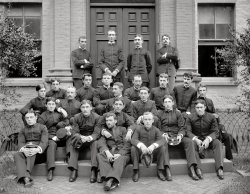
- Emancipation Day: 1905
- ... three years. I've been a fans of Walker Evans, Lewis Hine, Russell Lee, Dorothea Lange, and Arthur Rothstein, for most of my life. I even got to ... Posted by Dave - 07/27/2012 - 4:54pm -
![Emancipation Day: 1905 April 3, 1905. Richmond, Virginia. "Emancipation Day." See news item below. 8x10 inch dry plate glass negative, Detroit Publishing Company. View full size.
NEGROES' DAY CELEBRATED.
Inauguration of Colored President Part of the Ceremony.
Richmond, Va., April 3 -- Thousands of Negroes observed Emancipation Day in Virginia to-day. The occasion resulted in an outpouring of the race never before equaled, armed with miniature United States flags and attended by brass bands.
In addition, there was a unique feature to-night, the inauguration of a colored President. At True Reformers' Hall the interior of the White House was reproduced, and all the ceremonies incident to the induction of a Chief Magistrate into office were gone through with.
To-day was also the fortieth anniversary of the evacuation of Richmond by the Confederate forces and the partial destruction of the city by fire. (Washington Post, April 4, 1905.)
Hello! Mark Gooch!Awesome to run into a fellow Birmingham person on here! I grew up outside of Birmingham, in a little community called West Jefferson. I lived, as a child, about 4 miles from where Shorpy worked. I was fascinated and attempting to explore all the abandoned mining works around at the age Shorpy would've actually been working in them. (I also had a substitute teacher in elementary school with the last name of Higginbotham. I only had her once or twice, I believe she was retired. An amazing woman, very stern.)
This website is a continual source of inspiration and diversion for me. Like Mark, I have been drawn to the photographers he mentions since I can remember, and they inspired me to get an undergraduate degree in photography. I'm studying architecture in Texas now, and use these amazing images in my presentations from time to time as examples of good spaces lost, or to get at that piercing nag that historical images have.
This image is powerful to me not only because it foreshadows the groundswell that was civil rights, but also because I'm from a place that saw so much of that struggle. I am proud to be from this conflicted place, and I only hope that the progress continues. Emancipation Day should be a national holiday.
Great PictureThis picture suggests the wonderful hidden history of African Americans in the time after the Civil War. It's remarkable to think that for these people about as much time had passed since the end of the Civil War as has passed for us since the fall of Saigon. It's interesting to consider what memories and stories they were carrying with them.
A bit grim...For all that this is a commemoration/celebration, there seem to be more serious faces than not. Interesting that they had an inauguration! It was a 104 year early dress rehearsal, apparently.
Yes you can.Although none of those marching in this image would live to see it, I wish we could reach back and tell them that one day, it would happen. That today a black man is president of their country.
A particularly stylish womanA particularly stylish woman on the sidewalk next to the building on right caught my eye. Is she there with the man on her right and the three(?) children on her left?
What are the white men up in the law offices thinking? Who are the various white men among the crowd? Just passersby? Plainclothes? Any possibility they're actually participating/ celebrating?
Birthday greetings from Shorpy's Hometown!Happy Continuance Day Shorpy.com! I hope you continue for many years to come. I'm a professional photographer in Birmingham, Alabama. This is the proud home of Shorpy Higginbotham.
I'm like so many of your fans, I start my day looking at this site. I have for three years. I've been a fans of Walker Evans, Lewis Hine, Russell Lee, Dorothea Lange, and Arthur Rothstein, for most of my life. I even got to meet and visit with Rothstein once. It is such a privilege to view your photo offerings.
The picture above is very special to me. I grew-up in Columbus, Mississippi. Emancipation Day was celebrated on May 8. In Columbus this was known as "8 of May Day". I was always under the impression that May 8 was when the news of Emancipation reached Mississippi.
This site is such a gift. Thank You.
www.markgooch.com
Cheering Dixie?
Richmond Times Dispatch, Apr 4, 1905
Celebration of Day of Freedom
Negroes Cheered "Dixie" on
Their Emancipation Anniversary.
Nearly every colored man, woman and child in Richmond, and the surrounding territory, took part in or viewed the big emancipation parade yesterday.
The crowd was orderly and was the subject of favorable comments from all who saw the line as it passed along to the music of several bands. The parade consumed something like twenty minutes in passing a given point, and was made up of various negro clubs and societies. An amusing incident was the cheering of "Dixie" on this occasion.
After the principal streets of the city had been marched over, the crowds centered in the ball park, where the orators addressed the multitude on the subject most in mind. The principal speaker was D. Webster Davis, whose oration was loudly applauded. Rev. T.A. Green was the other speaker. During the speaking a board on the bleachers broke and caused a little excitement, but no one was hurt.
Last night there was a banquet of the leaders at Price's Hall, and at True Reformer's Hall a colored opera company held forth. The colored hotels and boarding houses were full to overflowing with excursionists and the ward was a dense mass of people all day and far into the night.
The thousands of local colored people on the streets were augmented by many from the country, who, in their gay rigs, added to the general interest in the parade. Old donkeys, with ante-bellum beards, marched beside negroes of the younger generation, and cooks, waiters, porters, washerwomen and barbers knocked off from work to join in the festivities incidental to the celebration of the day that really marks the fall of Richmond rather then the negroes' emancipation.
Times Change'Inauguration of Colored President.' The writer of that headline would never have dreamt in a million years that it would actually come to fruition. And cheering Dixie? Deep irony or carried away in the moment.
Where was this photo shotI have been trying to figure out exactly where (street/block) this photo was shot. The "John I Williams" bankers and brokers business in the background were apparently at 112 E Main Street at some time (according to court records) but the National Park Service says this image was taken in Jackson Ward, on the other side of town. Given the segregation of the time, I suspect this march was in Jackson Ward, "the Harlem of the south". Unfortunately, it seems that most of the original 1905 buildings in both areas are demolished today.
There were street car lines both on Main as well as 1st and 5th (which passed through Jackson Ward).
[This is somewhere in the main business district downtown. John L. (not I.) Williams was a prominent brokerage firm. The National Bank of Virginia is on the right. - Dave]
10th and Main downtownVirginia Commonwealth University's Rarely Seen Richmond puts this location at 10th and Main Streets with the Shafer Building at the corner and the old Custom House and Richmond Post Office in the background. The page also links to a photo of a somewhat different parade at the same street corner.
Attorneys Looking Out The WindowAttorneys Shelton and Atkinson looking out of their second story offices probably are celibrating celebrating with champiagn Champagne, knowing these people mean money in the bank from defending them (or prosecuting them). You know there is going to be some kind of lawbreaking going on with these people. There always is. Will the defendant please rise. ($$$)
Also, on ground level the photographer with his box camera and bodygaurd bodyguard can be seen keeping an eye out for troublemakers. Which probably was not that hard to find. I hope they were safe and un-harmed.
[What a dope. - Dave]
Jim Crow is a-waitin' The light skinned participants might be white pro-abolitionists, or, what was referred to in those days as 'High-yella', those whose ancestry made them less than septaroons, verifiably less than one sixteenth negro, and consequently able to 'pass' as white. It is a shameful legacy that we still employ, branding anyone of the lightest discernible African tint as colored. Partly black is black, while partly white is still black. "Free in body my brothers, but our souls are still in chains", those words still have relevance today.
(The Gallery, DPC, Streetcars)](https://www.shorpy.com/files/images/4a12513a.thumbnail.jpg)
- Cafe Texan: 1939
- ... Texas. View full size. 35mm nitrate negative by Russell Lee for the Farm Security Administration.
Re: Thin & Now Besides no ... Posted by Dave - 12/10/2007 - 2:03pm -
![Cafe Texan: 1939 April 1939. Street scene in San Augustine, Texas. View full size. 35mm nitrate negative by Russell Lee for the Farm Security Administration.
Re: Thin & NowBesides no obesity, most people are dressed sharply. No ripped jeans or baggy pants. It's very refreshing and I wonder if we'll ever return to a time like this.
What a reliefThe barbershop is sanitary.
All Those HatsInteresting how hat salesmen did such a great job in selling men a completely useless product back then. Notice how almost every man is wearing a fedora. Fortunately, we got over wearing those silly things. I wonder why we still waste our money on things like neckties? Does the edge of that sidewalk seem to drop off like a cliff? Nice looking roadster coming into view on the left.
Watch that first step!Does the sidewalk look very high off the ground? Why is that, maybe for a trolley?
[It's loading-dock height. Perfect for farmers with trucks. - Dave]
Re: All Those HatsSilly? Completely useless? Hardly. Keeps the sun out of your eyes, the rain off your face, and stylish too (nothing beats a nice snap brim fedora, as Bogart knew). If Nixon had won in 1960 we'd still be wearing hats. Kennedy hated wearing hats and after his inauguration refused to wear one.
Thin & NowEveryone in the photo is slim (we need a time machine) -- there were no McDonald's around and Cokes & Dr.Peppers were 6-ounce glass bottles (reusable).
Re: All those hatsSalesman? It's not too tough selling a hat to someone who spends most of life out in the hot Texas sun, son. Most of these gentlemen are not making "fashion statements"
San Augustine MemoriesMy aunt Exa Clark, maiden name Doggett, lived in San Augustine from the day she got married in 1927 until her death in 2003 or 2004. I came upon this picture by accident, but am very intrigued by it. I am sure my aunt knew some of the men in the picture & am equally sure they knew her. She was unforgettable. Her husband Ed & a man named Downs owned Clark - Downs Department Store in San Augustine. She took over her husband's place in the store when he died in the late 1940's.
re: "San Augustine Memories" comments"Ms Exa" Clark mentioned was my next door neigbor in San Augustine and she was unforgettable! What's funny is that the lady who owned the house we rented next to Exa's was also named "Exa." Her name was Exa Carrol.
(The Gallery, Stores & Markets)](https://www.shorpy.com/files/images/8a25910u.thumbnail.jpg)
- Santa Fe Time: 1939
- ... and Western Union. San Augustine, Texas." Photo by Russell Lee for the Farm Security Administration. View full size.
Extra keys ... Posted by Dave - 03/22/2018 - 10:57pm -
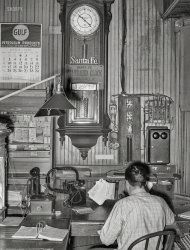
- Arsenal of Democracy: 1941
- ... engine at lower right.
M-3 Medium Tank (Lee) as opposed to the M-3 Light Tank (Stuart). The Confederate general ... The Stuart has four road wheels and no 75mm cannon and the Lee six road wheels.
Continental R-975 Based on the glimpse of the ... photo.
Photographer Is the photographer really Russell Lee? Per https://www.loc.gov/resource/fsa.8b00695/ , the ... Posted by Dave - 11/16/2020 - 4:55pm -
![Arsenal of Democracy: 1941 August 1941. Warren, Michigan. "Tank manufacture (Chrysler). These are partially completed M-3 tanks, 28-ton steel giants being turned out at the huge Chrysler tank arsenal near Detroit. The camera was directed toward the end of the three main assembly lines. Mass assembly methods developed in automobile manufacture are used. Note overhead cranes for heavy parts." Photo by Alfred Palmer for the Office for Emergency Management. View full size.
BookWhen I was younger, I found, in a used book store, a small book about the effort by an automotive manufacturer to build tanks for WWII. I believe it was actually published by the manufacturer to document their work after the war. Don't remember whether it was GM, Ford or Chrysler. But, it was a fascinating read, with pictures of the assembly process, at least one of them much like this one.
Previously on Shorpy --Quite a few Alfred Palmer 4x5 Kodachromes featuring M-3 crews training at Fort Knox have appeared on Shorpy. Here are a few:
M-3s in Action: 1942
Aim High: 1942
Fort Knox: 1942
Hits the SpotLooks like a very thrifty operation indeed, at least if judged by the recycled Pepsi-Cola bucket sitting on the floor just ahead of the stand-mounted engine at lower right.
M-3 Medium Tank (Lee)as opposed to the M-3 Light Tank (Stuart). The Confederate general names were applied by the British to distinguish the tanks, with the Grant M-3 being a modified version that suited the Brits more. They were used extensively in the North Africa campaign by the British, despite the tank being a stopgap measure until the M-4 Sherman could be developed. An unusual characteristic was the 75mm cannon in a fixed sponson on the right side because a turret capable of handling such a large gun hadn't yet been developed. The turret at the top held a rapid firing 37mm cannon.
As a little note, the tank pictured by Vonderbees is an M-3 Stuart light tank. The Stuart has four road wheels and no 75mm cannon and the Lee six road wheels.
Continental R-975Based on the glimpse of the yet-to-be installed engine on the floor in the bottom right-hand corner, this would appear to be one of the many thousands of Wright developed R-975 C1 air-cooled radial engines manufactured under license by Continental for use as a powerplant for Allied tanks and other armored vehicles.
http://usautoindustryworldwartwo.com/images/Continental%20Engine/r975-aa...
This engine in its C4 variant went on to be the main engine for the Sherman.
Not that the R-975 isn't a great engine (it is!) but it's a bit of a disappointment for me as I was hoping to catch sight of the Chrysler A57 Multibank. The A57 was a 30-cylinder 1,253 cid engine (five Chrysler 250.6 cid L-head inline six cylinder engines arranged around a central shaft) that was developed in 1941 out of the necessity for a rear-mounted tank engine to be developed and produced in the shortest time possible.
... and here I am, hijacking my own post about the R-975
For sheer output to space ratio, the Radial Engine configuration can't be beat.
Yank In A TankUpon further review, the tank on fire in the photo below is actually the M3 Stuart Light Tank which is different than the M3 Lee tanks in the manufacturing photo.
PhotographerIs the photographer really Russell Lee? Per https://www.loc.gov/resource/fsa.8b00695/, the photographer is Alfred T Palmer.
[It is indeed and the caption has been corrected. - Dave]
More About The PlantInteresting info here about the tank plant in the photo:
https://en.wikipedia.org/wiki/Detroit_Arsenal_Tank_Plant
Tanks!"Yer welcome!"
Amazing timesI continue to be amazed at how America mobilized for WWII, the massive output of war machines, airplanes and ships. And how the railroads managed to come back from very lean years with worn out equipment to handle all the traffic.
America truly came together.
I'll be 80 in two days and really all I can remember is my dad being on the road as a Frisco engineer and the huge number of trains running then.
(The Gallery, Alfred Palmer, Detroit Photos, Factories, WW2)](https://www.shorpy.com/files/images/SHORPY-8b00695u.thumbnail.jpg)
- Hot and Cold: 1936
- ... Dickens, Iowa." View full size. 35mm nitrate negative: Russell Lee, Resettlement Administration
In The Mirror Okay, so I'm intrigued by ... Posted by Dave - 04/08/2008 - 2:08pm -
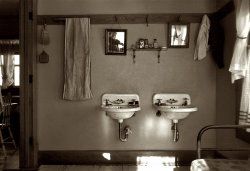
- Milestone
- ... Arthur Rothstein, Dorothea Lange, Jack Delano, Lewis Hine, Russell Lee, Walker Evans ... and tterrace. You move in some pretty good company, ... Posted by tterrace - 06/24/2009 - 4:14pm -
![Milestone It was one year ago, June 23, 2008, that I uploaded my first photos to Shorpy. Ironic that on that date, exactly one year less a day before Kodak discontinued the film, one of them was a Kodachrome. This is me, in Kodachrome, shooting Kodachrome with my Kodak Retinette, in July 1967. View full size.
Styling!This reminds me of the way I typically dress and comb my hair. Nobody my age tucks their shirt in so I'm trying to bring it back.
Happy anniversary, Tterrace!We're glad you're here and we love your photos. Keep 'em coming!
Thanks, TterraceYour photos and comments are part of what make Shorpy the best photo website I've seen.
Thank you so muchI like your photos, they are a big part of SHORPYs side. Thank you for every photo, keep on!
Photographers listI think tterace deserves to be included in the list in the right sidebar. Thanks, tterrace.
[Good idea. I've created a gallery for his posts called tterrapix. Now all he needs to do is to go back and "tag" his previous posts to make them appear in the gallery. - Dave]
Thanks a millionTo Erzsi for suggesting my gallery, to Dave for creating it and also to Dave for tackling the lion's share of the tagging, which I was bollixing up on my first attempt. Also to all the people who've said nice things about my photos. Viva Shorpy!
One of the ImmortalsHmmm, Ansel Adams, Arthur Rothstein, Dorothea Lange, Jack Delano, Lewis Hine, Russell Lee, Walker Evans ... and tterrace. You move in some pretty good company, buddy!
McNear's BeachI'm going to take a stab here, and say this was taken near McNear's Beach in San Rafael California. That is the Richmond-San Rafael bridge for sure in the background. I'll even say that it's a hill that you can climb and look down upon the Peacock Gap Golf Course.
Milestone locationThis is a section of this shot, so you're right about the bridge, rgraham, but it's actually on the hill overlooking downtown San Rafael, up Robert Dollar Drive in Boyd Park.
Ah hah!I think I know that location now. It's the hill that seems to get a fire going on at least once each summer. There used to be a cross on top of it, but I'm sure it's been taken down by now.
I can see 101 running off into the distance, heading over into Corte Madera, and Larkspur. I did in fact just cross that bridge twice this morning.
re: Ah hahActually, that's the approach to the Richmond-San Rafael Bridge, then State 17, now I-580. You can see the old westbound overpass from 101 near the right edge.
(ShorpyBlog, Member Gallery, tterrapix)](https://www.shorpy.com/files/images/anniversary.thumbnail.jpg)
- Cowlitz Crossing: 1941
- ... trestle for railroad." Medium format acetate negative by Russell Lee for the Farm Security Administration. View full size.
Trestle still ... Posted by Dave - 03/22/2022 - 4:31pm -
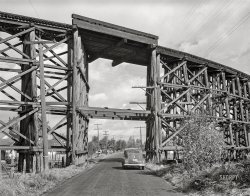
- Far Horizons: 1943
- ... than this trip by Delano? Maybe the only competitor is Russell Lee's visit to Pie Town, not all that far from where Delano took this photo. ... Posted by Dave - 10/04/2014 - 12:24pm -
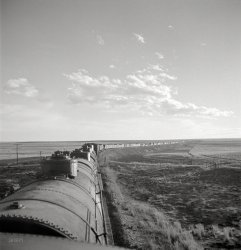
- Mound Bayou: 1939
- A colorized version of this 1939 photo by Russell Lee of storefronts in Mound Bayou, Mississippi. View full size.
Thanks! ... Posted by Fredric Falcon - 06/26/2009 - 1:25pm -
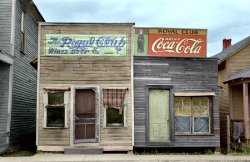
- Seventh Avenue: 1936
- ... and Seventh Avenue." View full size. 35mm negative by Russell Lee -- Resettlement Administration.
The guy in the middle reminds me of ... Posted by Dave - 09/09/2011 - 6:50pm -
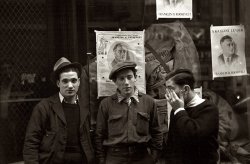
- Little Oklahoma: 1939
- ... as other Oklahoma products are for sale here." Photo by Russell Lee for the Farm Security Admin. View full size.
You can trust your car ... Posted by Dave - 06/15/2018 - 12:55pm -
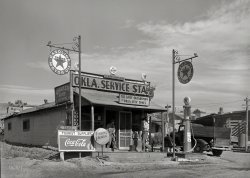
- Old Folks at Home: 1935
- ... evidence of this is determined by the photographs made by Russell Lee. There is no reliable history, at this point, that tells us exactly what ... Posted by Dave - 07/05/2009 - 2:04am -
![Old Folks at Home: 1935 October 1935. Brown County, Indiana. Prospective Resettlement Administration clients whose property has been optioned by the government. View full size. 35mm nitrate negative by Theodor Jung for the Farm Security Administration.
Resettlement?Can someone decode what the caption means? Resettlement clients? Property optioned? It sounds like their farm dustbowled up and the Roosevelt government is buying them out, but I'd like the official word... Thanks!
[Wikipedia article on the Resettlement Administration. - Dave]
Brown County INBrown County has the largest Indiana state park and part of the Hoosier National Forest. Brown County has by far the highest concentration of forested land of any of Indiana's 92 counties with nearly 90% coverage and almost no large farms at all. I think these people we relocated to help create these great parks.
http://www.fs.fed.us/r9/hoosier/docs/history/history.htm
Resettlement AdministrationThe resettlement of tens of thousands of people occurred through government action in the 1930s. In some cases it was for projects like the Tennessee Valley Authority where vast areas of bottom lands were flooded and the owners of the land, many of them having families that dated to the Revolutionary War period, were "resettled". In other cases, people lived on what the government determined to be submarginal lands and they were bought out and given the option of settling in a "homestead project" such as the ones developed by the FSA and, earlier, the Resettlement Administration. I don't know the particular history of Brown County, Indiana, where clients were "optioned", but it appears to fit that pattern.
However, in Louisiana at Transylvania Plantation just south of Lake Providence, blacks who had lived on the plantation since the Civil War were evicted by the FSA and white farmers were brought onto the land. The only evidence of this is determined by the photographs made by Russell Lee. There is no reliable history, at this point, that tells us exactly what took place and why (except for the photographic evidence). The result of the removal of hundreds of black tenants, their houses turned over to the new arrivals as well as their churches and community center, was an embittered and angry black population. They formed the nucleus of a particularly militant civil rights group based in Lake Providence. It appears that throughout the south the projects set up by the FSA had very long lasting implications.
The government had determined that FSA projects would be segregated, at the instigation of politicians, which was a profoundly different pattern for sharecroppers in particular who lived in racially mixed arrangements on the land. the result, time and again of this "resettlement" in the south was that whites and blacks were separated and concentrated in isolated communities. the black communities were often the font of civil rights work in their region. The white communities such as the Dyess Project in Arkansas were the centers of the Ku Klux Klan.
Here is a website that outlines some of our research:
http://www.siu.edu/%7ejadams/fsa/
(The Gallery, Great Depression, Rural America, Theodor Jung)](https://www.shorpy.com/files/images/8a14048u.thumbnail.jpg)
- Cheers (Colorized): 1937
- ... "Saturday night in a saloon." Medium format negative by Russell Lee, Farm Security Administration. View full size.
Where Everybody ... Posted by Kenny - 12/13/2011 - 11:37am -
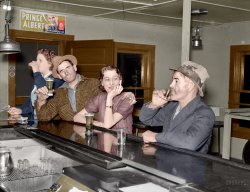
- T-Bone Steak 50 Cents (Colorized)
- ... Colorized version of one of the many fascinating photos by Russell Lee. View full size.
Great job! Great use of shades and hues! This ... Posted by DonW - 08/15/2011 - 8:16am -
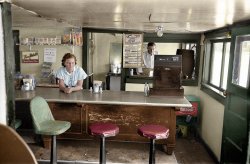
- Tuned In: 1941
- ... View full size. Medium format safety negative by Russell Lee for the FSA.
Radio I think the radio is an Airline 62-177 ... Posted by Dave - 01/29/2008 - 11:34pm -

- Fishing for Love: 1940
- ... When your parents think you're at "4-H" meeting. Photo by Russell Lee for the Farm Security Administration, wink wink. View full size. ... Posted by Dave - 06/23/2018 - 5:38pm -
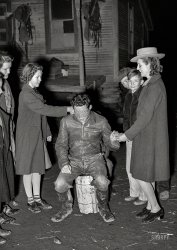
- Body at Rest: 1938
- A colorized version of this 1938 photo by Russell Lee. View full size.
(ShorpyBlog, Member Gallery, Colorized Photos) ... Posted by Fredric Falcon - 06/26/2009 - 12:44pm -
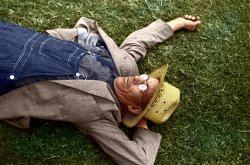
- Last Chance Texaco (Colorized): 1937
- ... 2. Western North Dakota." Medium format safety negative by Russell Lee for the FSA. I liked this picture and decided to colorize it. View full ... Posted by shtryh - 05/18/2010 - 12:15pm -
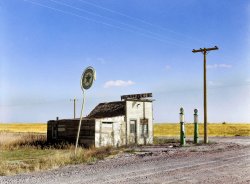
- Vagabonds (Colorized): 1939
- A colorized version of Russell Lee's photograph of a migrant worker and his wife, Wagoner County, Oklahoma, ... Posted by geod-SH - 03/09/2012 - 11:02pm -
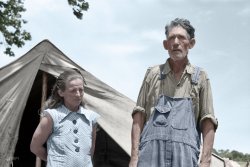
- Bye, Y'all (Colorized): 1939
- ... can see the footprint on the bench on the right side where Russell Lee(photographer)must have crouched back against the wall to take the T-Bone ... Posted by DonW - 08/29/2011 - 2:50pm -
